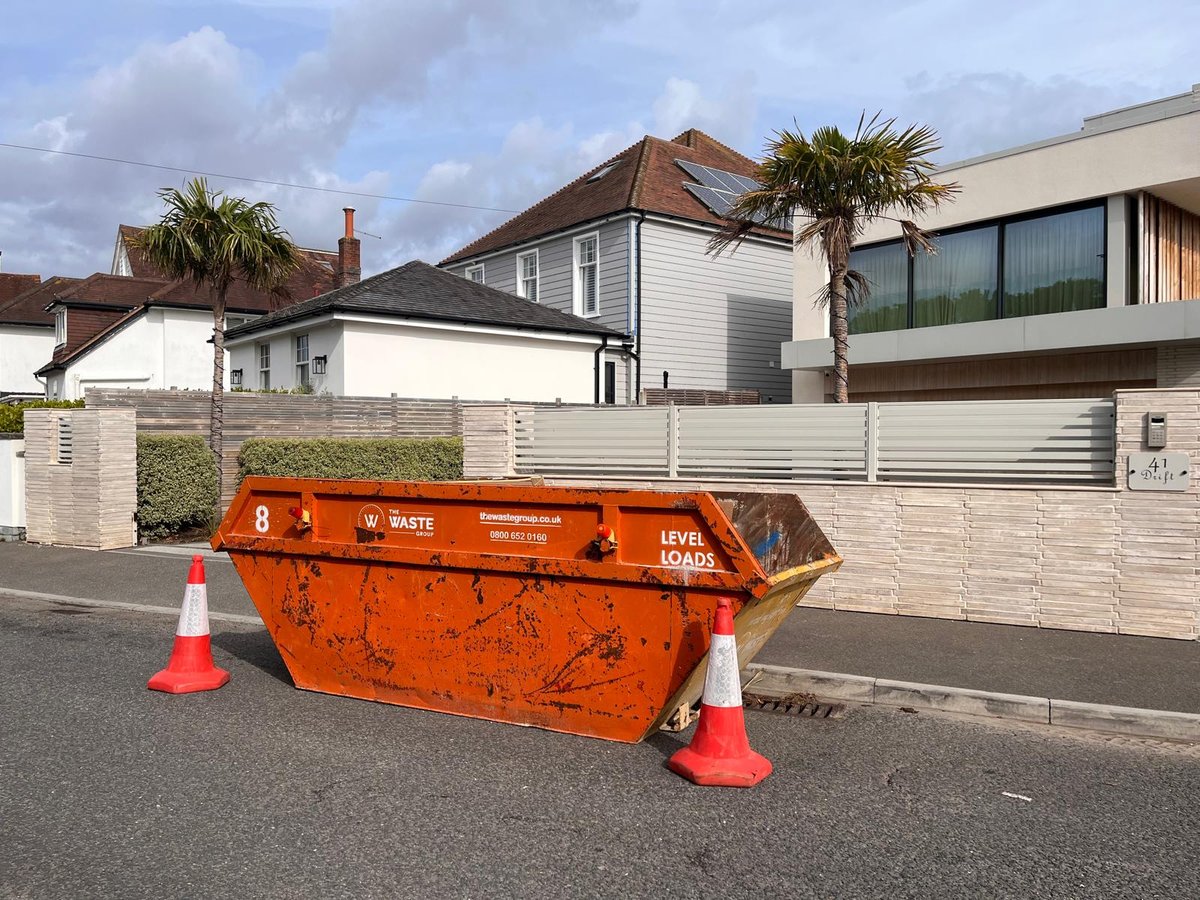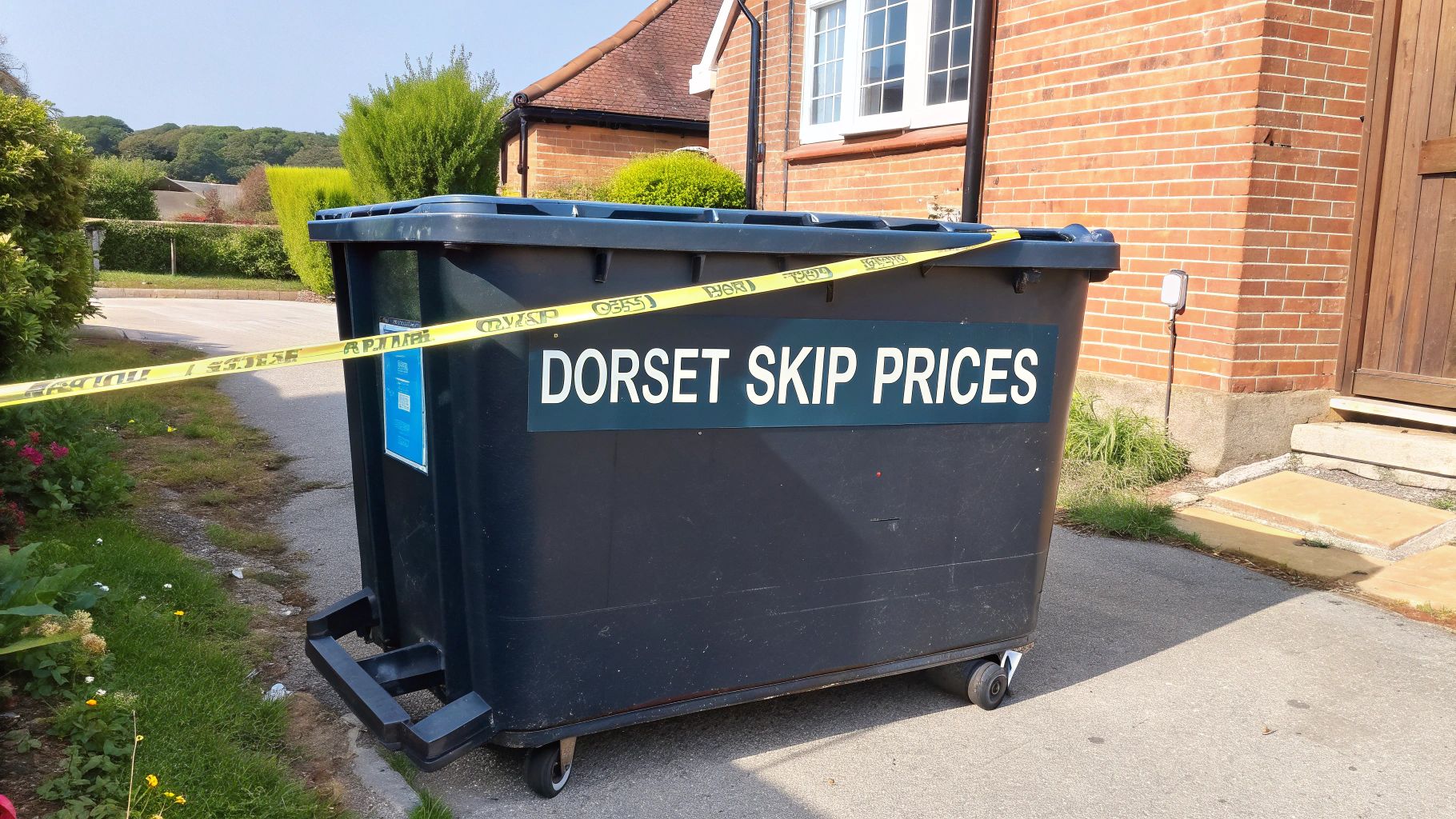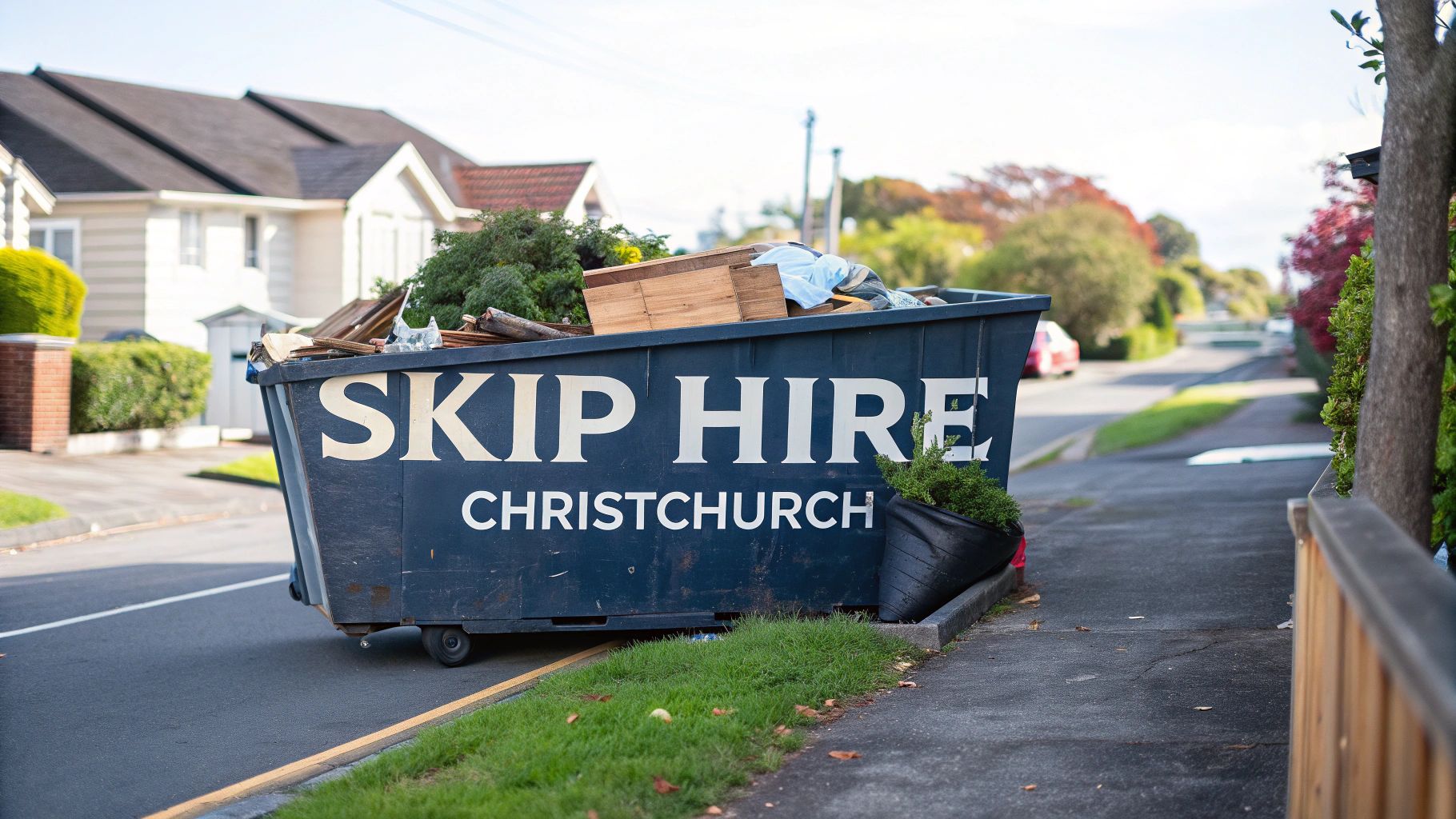How to Dispose of Plasterboard The Right Way
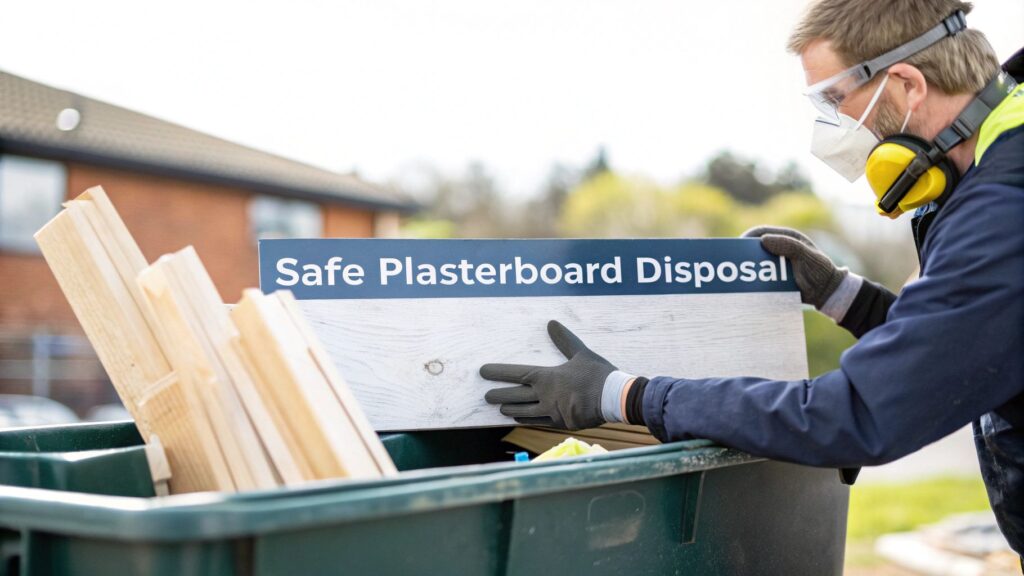
Before you even think about chucking that broken plasterboard into your general waste bin, let's stop for a moment. It's crucial to understand why this stuff is handled differently. Here in the UK, plasterboard disposal is strictly regulated, which means you absolutely cannot put it in your normal bin or a mixed-waste skip.
The reason is simple but serious: its gypsum core can release a pretty nasty toxic gas when it gets mixed up with all the other rubbish in a landfill.
Why Plasterboard Requires Special Disposal
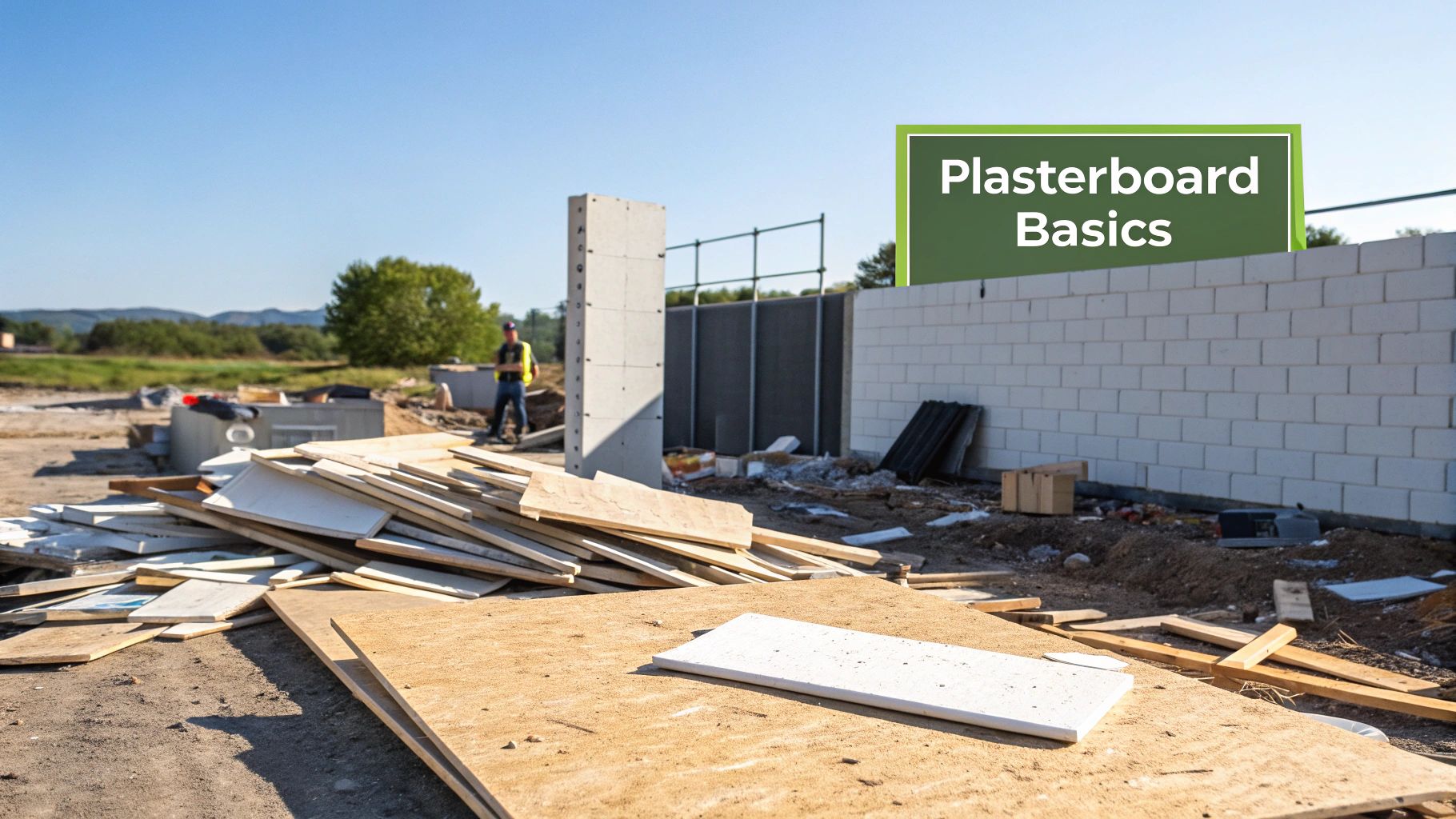
It’s a familiar scene for anyone who's done a bit of DIY. You've finished a project and you’re left with a few offcuts of plasterboard. The temptation to just slide them into the wheelie bin and be done with it is strong, I get it. But this is one material that demands a different approach.
The problem all comes down to its main ingredient, gypsum.
When gypsum breaks down in a landfill next to biodegradable waste like your potato peelings or garden cuttings, it creates the perfect storm for a chemical reaction. This process cooks up hydrogen sulphide (H₂S) — a toxic gas that smells just like rotten eggs. It's not just unpleasant; it’s genuinely harmful to the environment and our health.
The Science Behind the Rules
To tackle this exact risk, UK regulations treat plasterboard differently from your average construction debris. Back in 2009, the Environment Agency brought in rules that made it mandatory to separate plasterboard from all other waste. This wasn't just bureaucracy for the sake of it; it was driven by real concerns over landfill contamination.
In short, the law makes it illegal to chuck gypsum-based materials into a mixed landfill. This has some big practical implications for both homeowners and professional tradespeople:
- No Mixing Allowed: You simply cannot place plasterboard in a skip alongside other general waste.
- Council Restrictions: Your local recycling centre will have dedicated containers and specific rules for accepting it.
- Proof of Disposal: Proper disposal often requires documentation to prove the waste has been handled correctly from start to finish.
It's not just red tape. This rule is a critical environmental safeguard. Keeping plasterboard separate prevents the gypsum from reacting with organic waste, stopping hazardous gases from forming and protecting our groundwater from contamination.
Keeping Your Site Safe
Understanding why you can't just bin plasterboard is also about site safety. For any renovation or building project, it’s always a smart move to run through a comprehensive job site safety checklist to cover all your bases.
Ignoring these disposal rules really isn't worth the risk. A lot of people are still unaware of the specifics, but councils and waste management companies enforce them very strictly. If you try to hide plasterboard in a mixed skip, you could have the entire load rejected, landing you with extra costs and a major headache.
Getting this part right is the essential first step before we get into the safe and legal ways to actually get rid of it.
Comparing Your Main Plasterboard Disposal Options
So, you've got a pile of plasterboard to get rid of. Figuring out the best way to do it can feel like a bit of a puzzle, but it really boils down to three main options. Your choice will hinge on the size of your job, your budget, and how much heavy lifting you're prepared to do yourself. Getting it wrong can cost you both time and money, so let’s get into the practical differences.
The main routes are hiring a dedicated plasterboard skip, using a 'man and van' waste collection service, or taking it to a Household Waste Recycling Centre (HWRC) yourself. Each has its place, and a massive renovation will have completely different disposal needs to a small patch-up job in the spare room.
This image shows the typical journey for plasterboard waste in the UK and really highlights why choosing a recycling-focused method is so important.
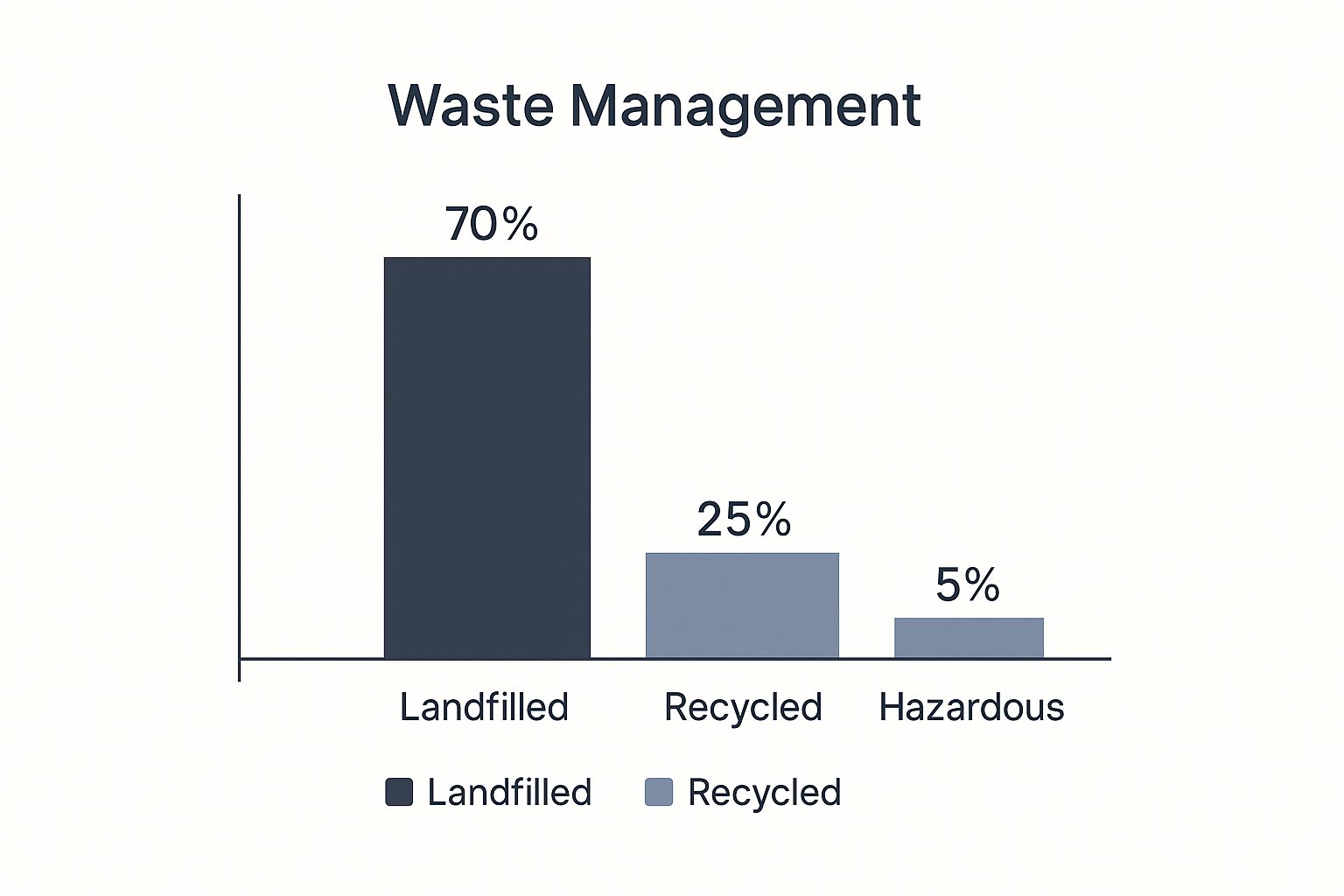
As you can see, a huge amount still winds up in landfill, which is exactly what the current regulations are designed to prevent.
H3: Plasterboard Skips For Large Volumes
If you’re gutting several rooms or tackling a major renovation, a dedicated plasterboard skip is often the most straightforward solution. It’s a single container just for your gypsum waste, meaning you don't have to stress about it getting mixed with other rubbish and falling foul of the rules.
You just fill it up as you work, and the company collects it when you're finished. This is perfect for projects that generate a steady stream of waste over a few days. The cost is fixed for the skip size, which makes it much easier to budget for large quantities.
A plasterboard-only skip is your best bet for large-scale projects. It eliminates the risk of mixing waste streams and simplifies the entire disposal process, ensuring you stay compliant with UK law.
The only downside? For smaller jobs, you might be paying for a lot of empty space, making it less cost-effective. You also need to have enough room on your property, like a driveway, to place the skip legally and safely.
Man and Van Collections For Convenience
For small to medium-sized jobs, a licensed 'man and van' waste collection service offers incredible flexibility. This is the perfect answer when you’ve taken down a single wall or have a pile of offcuts that just won’t justify hiring a whole skip.
You only pay for the exact volume of waste they remove, which can work out much cheaper for smaller amounts.
This option is also brilliantly convenient. The collection team does all the heavy lifting for you, clearing the waste from wherever it is on your property. This saves you the back-breaking effort of loading a skip or hauling heavy bags to your car.
- Pay for what you throw: A great way to avoid the cost of a half-empty skip.
- Labour included: They load the waste for you, saving you the hassle.
- Quick removal: Often available for same-day or next-day collection.
It is absolutely crucial to ensure any service you use is a registered waste carrier. Always ask for their licence number; a reputable company will have no issue providing it. Choosing a responsible operator is a key part of many sustainable waste management strategies and protects you from any legal headaches if the waste is fly-tipped.
Taking It to the Council Tip
For the dedicated DIYer with just a few sheets of plasterboard to dispose of, the local Household Waste Recycling Centre (HWRC) is a perfectly good option. Most councils will allow residents to get rid of a limited amount for free each month.
The main drawback here is the physical effort involved. You'll need to bag it all up correctly, load it into your vehicle, and drive it to the centre yourself.
You must also check your local council's specific rules in advance—many now require you to book a slot online and have very strict limits on how much you can bring. It's a fantastic free option, but it's really only practical for very small amounts.
Plasterboard Disposal Options Compared
Choosing the right disposal method can make a huge difference to your project's budget and timeline. To help you decide, here's a quick side-by-side look at the most common options.
| Disposal Method | Best For | Typical Cost | Key Advantage | Key Disadvantage |
|---|---|---|---|---|
| Dedicated Plasterboard Skip | Large renovations, new builds, big clear-outs | Fixed price per skip size (£100-£300+) | Handles large volumes easily; ensures compliance | Not cost-effective for small jobs; needs space |
| 'Man and Van' Collection | Small-to-medium jobs, single rooms, offcuts | Based on volume (£50-£150+) | Convenient, flexible, labour included | Can be expensive for very large quantities |
| HWRC (Council Tip) | Very small DIY jobs, a few sheets or offcuts | Usually free for residents | No cost | Labour intensive; strict quantity limits |
Ultimately, the best choice comes down to the scale of your waste. For anything more than a few sheets, a professional service like a skip or a 'man and van' collection is not just easier but ensures you're disposing of it legally and responsibly.
Using Your Local Council Recycling Centre
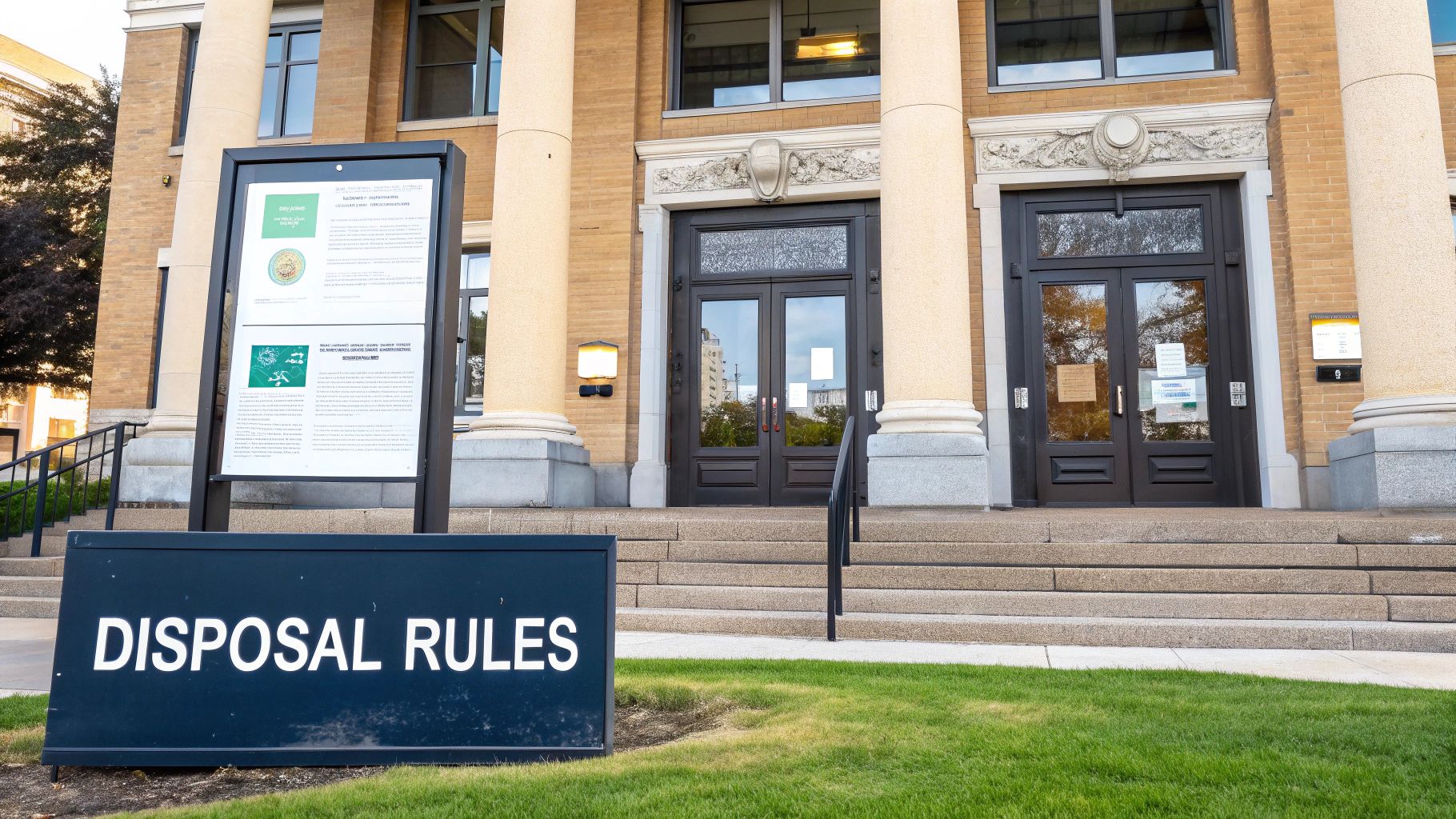
If you've just finished a small DIY job and only have a few plasterboard offcuts to get rid of, heading to the local tip seems like the obvious choice. It's often the cheapest way to handle small amounts, but it’s rarely as simple as just chucking it in the boot and driving down.
Before you go anywhere, the first thing you absolutely must do is check your local council's website. Rules for Household Waste Recycling Centres (HWRCs) can be wildly different from one area to the next. Many now run a booking system to keep things flowing, so you might need to grab a slot online a few days ahead. Turning up unannounced is a recipe for a wasted trip.
Check Allowances and Charges Before You Go
Most councils will let you drop off a bit of plasterboard for free as a resident, but these "DIY allowances" are usually pretty tight and strictly monitored. Go over the limit, and you'll find yourself paying, with costs that can quickly mount up.
For a real-world example, take a look at Somerset Council. They let residents bring up to eight 50-litre sacks (or the equivalent of a couple of full boards) for free each month. You can even spread this out over four visits. But the moment you go over that, it’s £6.30 for every extra sheet or bag. You can see their full list of on-site charges in Somerset to get a feel for how these things are structured.
This is exactly why a quick check online beforehand is so critical. You'll know what to expect and can figure out if the tip is still your most budget-friendly option.
How to Prepare Your Plasterboard for the Tip
This is non-negotiable: recycling centres will only take clean plasterboard. If it’s mixed with other materials, the staff have every right to turn you away, and they almost certainly will. Getting it ready before you leave home is key.
Here’s a simple checklist to make sure your load gets accepted:
- Strip it bare: Get rid of everything that isn't plasterboard. That means tiles, wallpaper, old insulation foam, and bits of wood. Scrape it all off.
- Remove all fixings: Every last screw, nail, and plastic wall plug has to come out.
- Keep it separate: Bag up your clean plasterboard on its own, away from any other rubbish you're taking.
A classic mistake we see all the time is people trying to dump old bathroom plasterboard with the ceramic tiles still stuck on. The recycling machinery simply can't process it. A few minutes of prep work at home will save you a world of hassle at the gate.
Finally, think about how you're getting it there. Bagging up the smaller bits makes them much easier and safer to carry. If you have larger sheets, make sure they're properly secured in your vehicle. Once you arrive, look for the special container marked "Plasterboard" or "Gypsum", and don't forget to bring proof of address – they will ask for it.
Hiring a Skip for Plasterboard Waste
When you're knee-deep in a big renovation, hiring a skip just seems like the most sensible way to handle the growing mountain of waste. It keeps your site tidy and saves endless trips to the tip.
But when plasterboard is involved, you can’t just chuck it in with everything else. There are strict UK rules in place, and if you get them wrong, you could be looking at rejected loads and some pretty hefty fines.
The golden rule is this: plasterboard must never be mixed with general waste. Because of its gypsum content, it has to be kept separate to stop toxic hydrogen sulphide gas from being released in landfills. This gives you two clear options when hiring a skip.
Plasterboard-Only Skips
If your project is generating a serious amount of plasterboard waste, hiring a dedicated plasterboard-only skip is by far the cleanest and safest way to go. It’s exactly what it sounds like—a container reserved for nothing but your plasterboard.
You simply fill it up with clean plasterboard, making sure it’s free from other materials like tiles, insulation, or timber. Once it's full, the skip company takes it away, ensuring it goes directly to a specialist recycling facility. This is the go-to method for tradespeople as it makes the whole process hassle-free.
Using Plasterboard Bags in a Mixed Skip
What if you have a bit of both? A mix of general waste and a smaller amount of plasterboard? In this situation, you can usually use special plasterboard bags inside a standard mixed-waste skip. Most reputable skip companies will be able to supply these tough, purpose-built bags.
You just fill the bags with your plasterboard offcuts and place them right on top of the other rubbish in the skip. This keeps the plasterboard safely contained and separate from the general waste, satisfying the legal requirements while letting you use just one skip for everything.
Top Tip: Always double-check with your skip hire company that they accept plasterboard in dedicated bags before you book. Policies can vary, and a quick phone call can save you a lot of headaches on collection day.
No matter which route you take, there’s some paperwork you can't ignore. When your skip is collected, make sure you get a Waste Transfer Note. This document is your legal proof that you’ve handed your waste over to a licensed carrier. It’s what protects you if the waste ends up being fly-tipped down the line.
Of course, plasterboard is often just one part of the puzzle. Construction sites create all sorts of waste, and managing it all properly is key. For a wider view, this straight-talking guide to construction site waste management is a great resource.
And if you’re ever unsure about the basics, getting a clear picture of what can go in a skip is the best place to start.
The Importance of Plasterboard Recycling
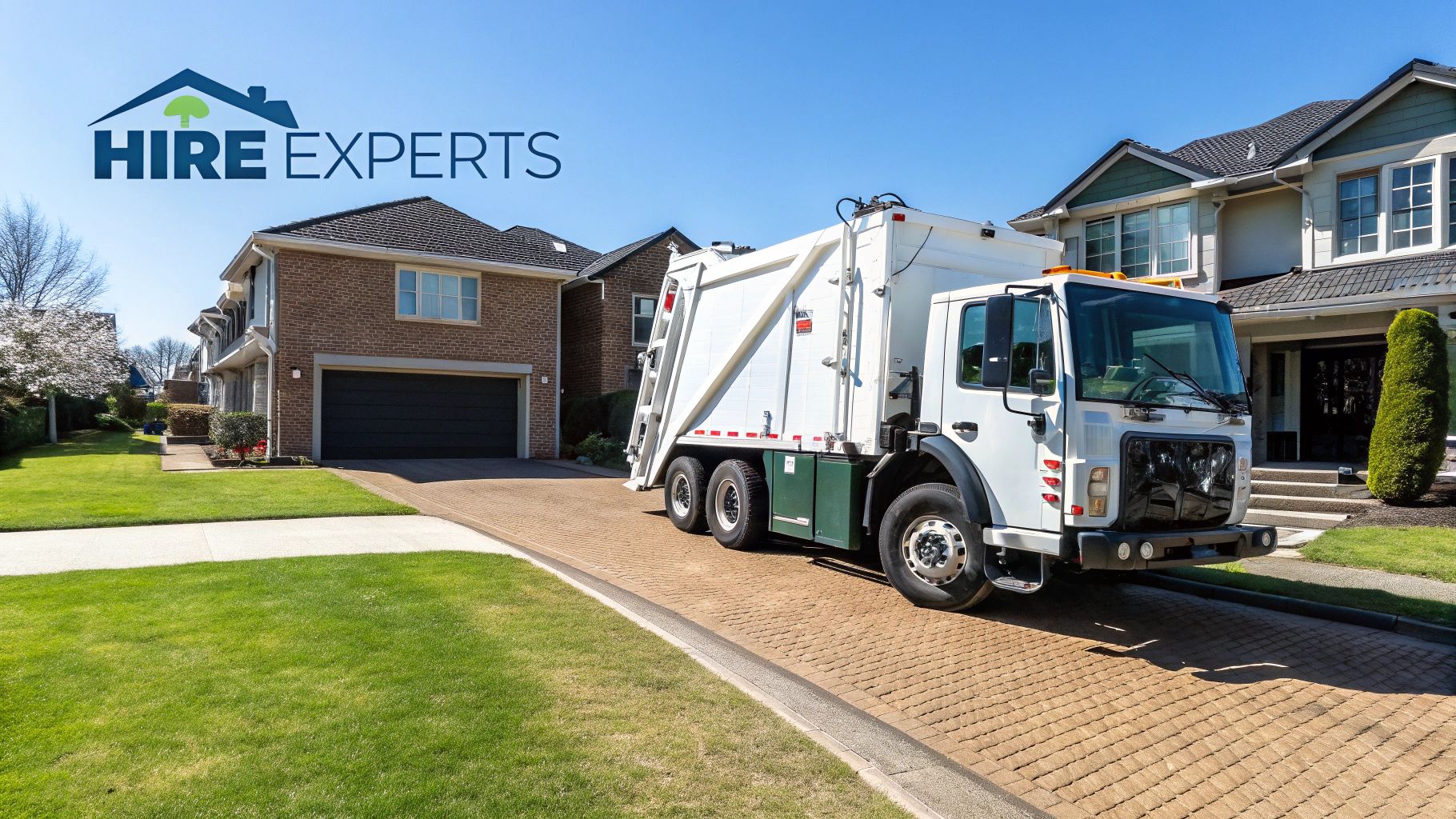
Getting rid of plasterboard the right way is about much more than just following the rules; it’s a massive part of building and renovating sustainably. When you choose to recycle, you’re not just chucking out waste—you’re feeding valuable materials straight back into a circular economy.
The sheer scale of plasterboard use in the UK is staggering. Every year, around 270 million square metres of it are made, which chews through about 3 million tonnes of raw gypsum. What’s really surprising is how much of this becomes waste. It’s not always from demolition, but often from simple off-cuts during installation—sometimes as high as 30%.
The Plasterboard Recycling Process Explained
So, what actually happens to your old plasterboard once it’s sent for recycling? It’s a pretty clever process that recovers the two main ingredients: the gypsum core and the paper lining.
Specialist facilities shred the boards and then separate the two materials. The recovered gypsum is so clean and pure that it can be used to manufacture brand-new plasterboard, cutting down the need to mine for virgin gypsum, which is a finite natural resource.
By recycling, you are directly contributing to a closed-loop system. The gypsum from an old wall you’ve torn down can be processed and end up back on the shelf as a new sheet of plasterboard, ready for the next project.
Benefits Beyond New Boards
The recovered gypsum has other uses you might not expect. Once it's been processed, it can be repurposed as a high-quality soil conditioner for agriculture. Farmers actually use it to improve soil structure and give crops essential nutrients like calcium and sulphur.
Thinking about it this way, recycling plasterboard makes perfect sense:
- Conserves Natural Resources: It massively reduces the demand for new gypsum mining.
- Reduces Landfill Burden: Every tonne recycled is a tonne that isn't taking up precious landfill space.
- Lowers Carbon Footprint: Manufacturing with recycled materials almost always uses less energy than starting from scratch.
Choosing a disposal method that focuses on recycling, like a dedicated skip or a licensed collection service, is a powerful decision. You can find out more about why you can't put plasterboard in skips with your general rubbish in our detailed guide.
And it’s not just about plasterboard. Understanding how to handle other household items responsibly is just as important. For more info, check out this fantastic guide to recycling old domestic appliances. When we all think sustainably about our waste, we make a real, collective difference.
Common Plasterboard Disposal Questions
Even after covering the main disposal routes, you might still have a few nagging questions. Getting the details right is what makes the difference between a smooth job and a stressful one, so let’s tackle some of the most common queries we hear.
Can Small Pieces Go in My Regular Bin?
This is probably the number one question we get asked, and the answer is a firm and absolute no. UK law is crystal clear on this: plasterboard is banned from general waste collections, no matter how small the pieces are.
Even a handful of offcuts tossed into your wheelie bin can create toxic hydrogen sulphide gas when mixed with other waste in a landfill. Councils are very strict about this. If they spot gypsum waste in your bin, they can refuse to collect it, leaving you to sort it out properly.
What if My Plasterboard Has Tiles or Insulation on It?
You’ll need to separate everything before you try to get rid of the plasterboard. Whether you’re heading to the local tip or booking a collection, they will only ever accept clean plasterboard.
This means stripping off all the other stuff first:
- Ceramic tiles
- Wallpaper and old adhesive
- Screws, nails, and wall plugs
- Insulation foam or boards
Think of it like cooking – you have to prep the ingredients. The clean plasterboard goes into the gypsum recycling stream, while tiles, screws, and other bits have to be disposed of in their own categories. Any plasterboard that’s still contaminated will almost certainly be rejected on the spot.
A common mistake is thinking a "little bit" of wallpaper or tile adhesive won't matter. It really does. Recycling plants use machinery that can be damaged by these contaminants, which is why the "clean plasterboard" rule is enforced so strictly.
Is a Skip Cheaper Than a Waste Collection Service?
This really comes down to how much waste you’re dealing with. There's no single cheap option; it's about what’s most cost-effective for your particular project.
For a small job, like clearing out a single room or getting rid of a few offcuts from a repair, a licensed 'man and van' style service is often the better financial choice. They usually charge for the exact amount they take, so you aren't paying for empty space.
But for bigger renovations that generate a lot of plasterboard waste over several days, hiring a dedicated skip is typically more economical. The fixed price often works out cheaper per cubic metre when you have larger volumes. The best advice? Get a quick quote for both to see what makes sense for your budget.
How Do I Find a Licensed Disposal Company?
Using an unlicensed operator is a massive risk. If your waste ends up fly-tipped, you could be the one facing a hefty fine. The safest way to check if a company is legit is to use the Environment Agency's public register of waste carriers.
Any reputable skip hire firm or waste collection service will have their Waste Carrier Licence number displayed on their website or will give it to you if you ask. Don't be shy about asking for it. This simple check gives you peace of mind that your plasterboard is being handled legally and responsibly the second it leaves your property.
For hassle-free, legally compliant plasterboard disposal, The Waste Group offers dedicated skips and collection services across Dorset. We guarantee responsible recycling and provide all the necessary paperwork, so you can focus on your project with confidence. Get an instant quote and book online today at https://www.thewastegroup.co.uk.
Article created using Outrank
